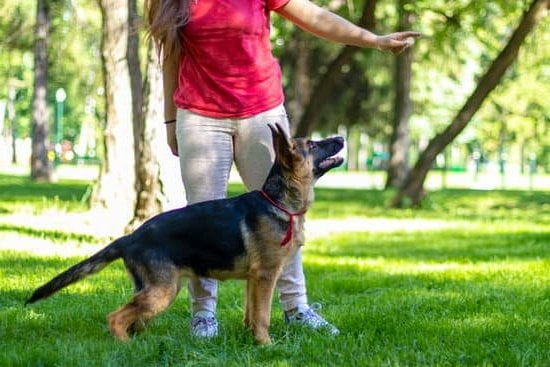Introduction
Dogs bark! But sometimes all that barking can become too much and it’s necessary to train your beloved pup to not bark unnecessarily. Whether it’s because you have a mischievous pooch who loves to alert you whenever there is a stranger around, or an anxious pup who barks at every little noise, learning how to properly get them not to bark will take patience, focus and lots of love. Without further ado, let’s go through the steps on how to get your dog trained to not bark.
Step 1: Identify the Problem
The first step in determining how to best stop unnecessary barking is identifying the problem. Analyze why your dog is barking. Is it out of fear? Anxiety? Excitement? Territorial protection?Hungry? Answering this question will help you better understand how to address the problem and move forward with training strategies.
Step 2: Positive Reinforcement
Once you determine why your dog is barking, begin by introducing positive reinforcement when the dog does not bark when he should remain quiet. For instance, if your dog barks when people come over, give him treats and praise for maintaining calmness when visitors arrive. This will slowly help teach them that being quiet is more desirable than vocalizing their need for attention or acting out of behavior caused by emotions such as fear or excitement.
Step 3: Consistent Commands
In order for your pup to really learn not to bark, provide them with consistent commands using verbal cues each time they demonstrate undesired behavior along with corrective actions if needed so that they are aware of whatis expected from them. By repeating these phrases consistently each time they display difficult behaviors while simultaneously providing rewards when they remain silent will start teaching them what type of behavior is deemed appropriate and what isn’t wanted by those in charge. Training like this needs consistency so make sure all family members are trained on the same commands as well so that everyone provides consistent reinforcement throughout all stages of training periods.
Conclusion: With dedication and patience training a dog not to bark excessively can be successful ultimately saving both you and your furry friend potential embarrassment down the line when they don’t bark at inappropriate times and places. Start from scratch with basic beginner commands but be sure always reward desired behaviors along with repeated corrections for problematic ones in order for learning natural boundaries becomes swiftly ingrained into their behavior. Good luck!
Step One
It is important to understand why your dog may be barking in order to effectively get him trained not to bark. Common oldies are boredom, isolation, play, protection/alarm and attention seeking. If the barking is out of boredom, make sure your pup has plenty of toys and activities available to keep entertain himself. If it is due to isolation, try to create more socialization opportunities for your buddy as this will go a long way in reducing his stress levels. On the other hand, if the barking is related play or attention-seeking behavior, make sure you respond only when he isn’t barking. Give plenty of praise while reinforcing desired behaviors that do not include barking. Lastly, if your pet barks at strangers or loud noises outside the home, desensitization can be an effective course of action. You can do this by exposing him to these stimuli from afar and rewarding calm behavior with treats and positive reinforcement.
Step Two
Establishing a training schedule is key to teaching your dog not to bark. Dogs need consistency and reliability from their owners, so it is important to set aside regular and consistent times for training. This could include times such as when you are about to leave for work in the morning, or when you get home from work in the evening. Make sure that these training sessions occur at the same time each day, so that your dog gets used to them and knows what to expect. During each session, focus on teaching your dog commands like “sit”, “stay” and “quiet”. If possible, enlist the help of a professional trainer to assist you with these sessions, who will be able to provide expert advice and guidance when needed. Finally, remember to reward good behavior – apart from verbal praise, treats can also be given out as rewards for keeping quiet when commanded!
Step Three
Positive reinforcement and rewards are essential to training any dog not to bark. To begin, think about things your pet likes and reward it with a favorite treat each time it doesn’t bark when you tell it to be quiet. Do this consistently over time and your pet will learn that the reward comes in exchange for being quiet. Additionally, make sure to praise your pet with verbal rewards, like praise or affectionate words, whenever it follows your commands properly. As long as you stay consistent and patient, your dog will soon learn the desired behavior.
Step Four
Once your dog has learned to bark on command, it’s time to teach him a suitable alternative. Many owners opt for the “quiet” or “hush” command. To do this, each time you issue a regular “speak” command and your dog barks, put a treat close to its nose and tell them “hush” or “quiet”. Firstly your dog will go still to investigate the treat and by doing so will stop barking; when they do so make sure you reward them immediately with a treat. Repeat this sequence until eventually you will not need the treats and just saying the word “quiet” or “hush” is enough for them to stop barking. If they start barking again just repeat the lesson but don’t forget to reward them when they are quiet. Once your pup gets the hang of it, he’ll be able to show an impressive level of restraint when told to hush!
Step Five
When your dog barks at people passing by or other animals in the vicinity, redirect their focus away from them instead of scolding them. Scolding may make your pup become more protective or aggressive and they’ll be more likely to bark next time they have a similar encounter. Instead, hold up a treat or toy in front of them and ask it to sit. Give your pup verbal praise and treats when they exhibit positive behavior like sitting quietly while other people pass by or animals move around. Use this method every time they try to bark when there are external disturbances, and eventually, they will learn that barking leads nowhere while being quiet will get them attention and rewards.
Step Six
Identifying potential triggers in your dog’s environment and minimizing them is a key step in getting your dog not to bark. Start by taking note of any objects, situations, or people that can prompt your pup to become vocal. You may find they are repeatedly barking at other animals outdoors like cats or birds, vehicles or people walking by, loud noises like thunder, or visitors entering the house.
Once you have identified all the potential triggers in your pup’s environment you can then work towards reducing how often they are exposed to these things. This could be done by restricting their access to certain spots near windows or moving them away from busy streets for example. Or it could be done by desensitizing their response through using positive reinforcement training so that eventually unfamiliar sights, sounds and smells don’t cause such a strong reaction from them each time.
Step Seven
When training a dog to not bark, it is important to take your time and give your dog regular breaks during the process. This can help prevent boredom and ensure that the dog does not become overwhelmed or frustrated by the task. Breaks can also provide you with a chance to step away for awhile and reassess your training methods. During breaks, it is beneficial to engage in activities that involve positive reinforcement such as playtime, petting or offering treats/toys. You could also use this time to practice commands or agility exercises that reward good behavior. Make sure to reward any progress during these breaks as well! Applying consistent, patient training while providing regular breaks will help create lasting habits and reduce barking over time.
Conclusion
Conclusion: Training your dog not to bark is a great way to create a happier and less stressful home life for you and your dog. The steps outlined above provide a great overview of what is needed for successful barking training. Start by identifying triggers, understand the motivations behind the barking, and use positive reinforcement techniques when working with your pup. With consistent practice and patience, you will soon have a well-behaved pet that no longer barks excessively. Ultimately, taking the time to train your dog not to bark will save both of you a lot of stress in the long run.

Welcome to the blog! I am a professional dog trainer and have been working with dogs for many years. In this blog, I will be discussing various topics related to dog training, including tips, tricks, and advice. I hope you find this information helpful and informative. Thanks for reading!





